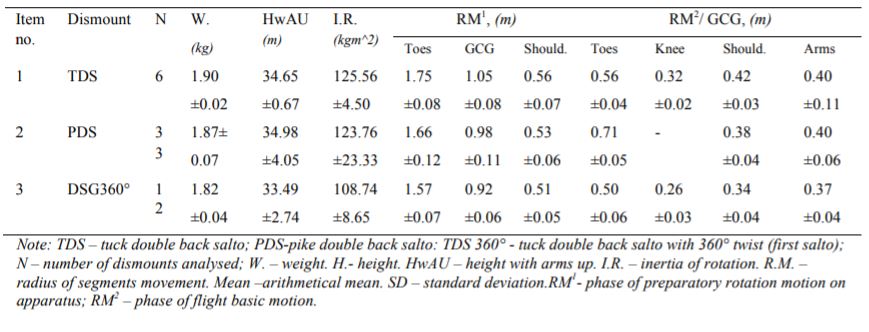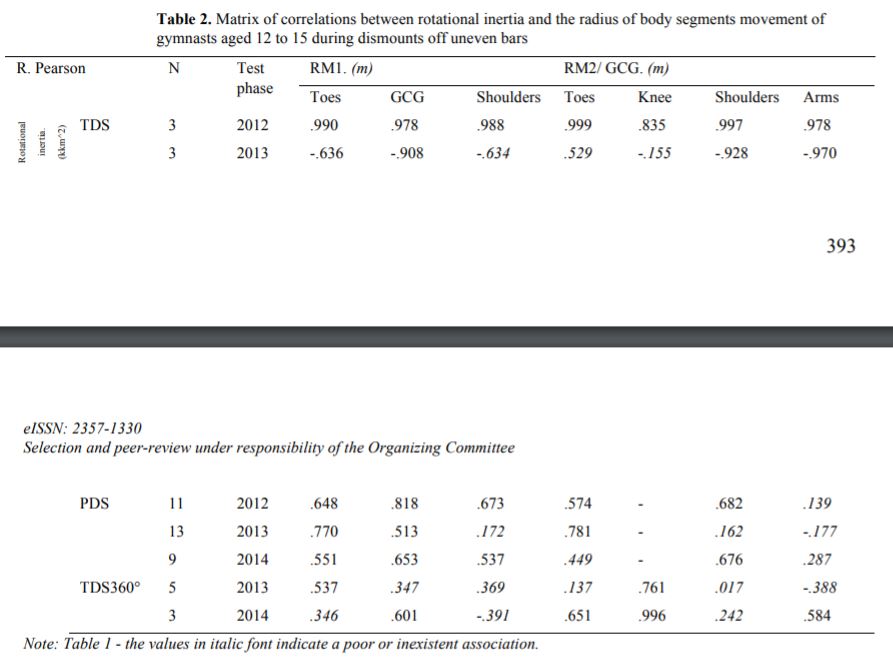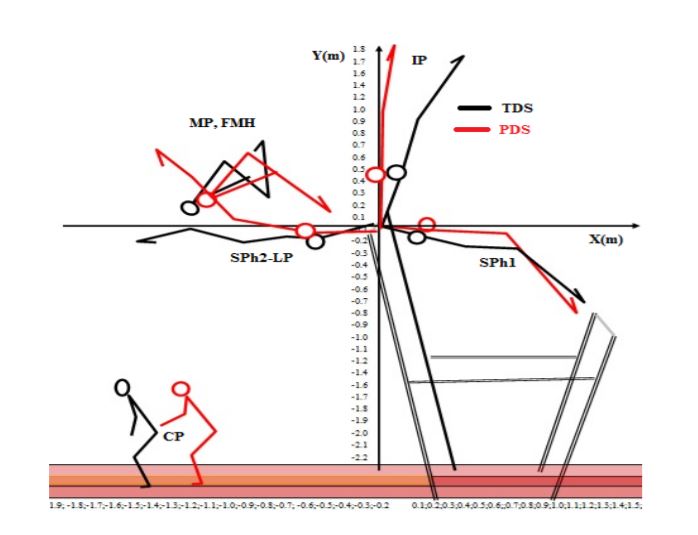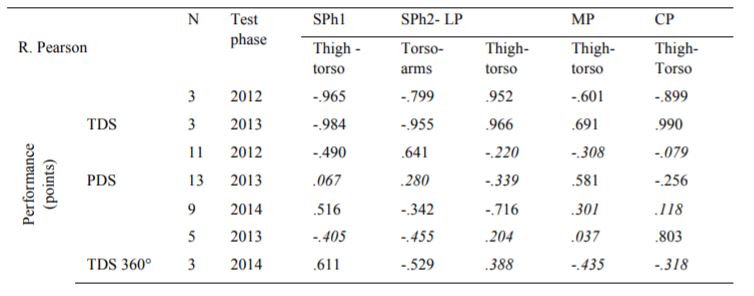Mathematical Modelling of the Biomechanical Characteristics of the Dismounts off Uneven Bars in Women’s Artistic Gymnastics
Abstract
The purpose of this paper is to develop a mathematical model based on the use of video biomechanical analysis of dismounts off uneven bars. This scientific approach led to the organization of an experimental study using the following research methods: Analysis of specialized literature; Computerized video method, by using “Pinnacle Studio” program of video capture and processing and “Kinovea” and ”Physics ToolKit” programs for biomechanical video analysis of sports technique; Method of mathematical modelling; Method of movement postural orientation for analysis of sports technique key elements; Statistical method, through ”KyPlot” computerized program. The research was conducted between 2012 and 2014, and was attended by 16athletes aged 12 to 15, members of the Romanian national junior team. In this respect, 51 dismounts performed in three national competitions were analysed biomechanically; results of the kinematic and dynamic characteristics and performances achieved in competitions were statistically correlated. It was highlighted the correlative linear significance of the indicators of the kinematic and dynamic characteristics of the rotary motion around a fixed point on the apparatus – preparatory movement and around the transversal axis of GCG in the flight phase of dismounts consistent with the anthropometric, biomechanical and performance parameters of gymnasts for developing the mathematical model of dismounts off uneven bars in women’s artistic gymnastics. The effective use of the linear statistical method in the mathematical modelling of the biomechanical characteristics and sports performances created the possibility to deepen the phasic preparation of sports training and to process more efficiently the modern didactic learning programs.
Keywords: Gymnastics, mathematical modelling, biomechanics, dismount, performance
Introduction
At the present moment, artistic gymnastics has recorded remarkable progresses, reaching a really high level of development so that gymnasts’ performances differ by new elements, increase of difficulty, complexity and spectacular character of exercises, concomitantly with the improvement of technique and execution mastery (Arkaev & Suchilin, 2004; Potop, 2014; Vieru, 1997: 238).
Analysing the technique of gymnastics exercises based on biomechanical positions, one shall use the “arithmetic” entry, involving operations of practical problems improvement (Smolevskij & Goverdovskij, 1999: 260). In this context, it is obvious that every modern sport is based on different exercises depending on the general volume of the specific structure and material, the problem of motor skills transfer being highlighted differently (Gaverdovskij, 2007: 308).
In conformity with the requirements and the specific character of women’s artistic gymnastics apparatus, the elements on uneven bars can be divided into several structural groups, defined not only according to their execution way, but also according to their purpose, namely: handstands, hip circles (small and big), free passing over bars, somersaults and re-grasping, simple switches on longitudinal axis or made during different basic movements, transitions from one bar to another, mounts and dismounts (Bibire & Dobrescu, 2008: 40; Gaverdovskij, 2014; Grosu, 2004: 21; Vieru, 1997: 238); the dismounts off uneven bars correspond to the 6th group of the International Code of Points, with the following difficulty groups and values: group B – 0.2 points – double back tuck salto, group C – 0.3 points – double back pike salto, and group D – 0.4 points – double back tuck salto with 360° twist in the first salto.
In the specialized literature, the general problems of biomechanical analysis of contemporary technique and the knowledge of factors decisive for the technical training and contents of the optimization of gymnastics training are insufficiently treated and known. Current concerns in scientific research on the biomechanical issues in gymnastics and the characteristics of rotation routines were expressed by Crețu, Simăn, & Bărbulescu, 2004; Hiley & Yeadon, 2005, 2007; Potop, Grad, & Boloban, 2013; Potop, 2014 etc.
There are many studies that refer to the mathematical modelling in sport; in terms of artistic gymnastics, we shall refer to some of them, namely: “Mathematical modelling of locomotion of biomechanical system” (Pokatilov, 2013); “Modelling of young gymnasts’ training process” (Hudolei, 2005); “Influence of the changes of mass-inertia characteristics of the bio-system modelling based on the biomechanical parameters of back giant on high bar” (Zagrevskij & Zagrevskij, 2005);
“Mathematical modelling of back giant” (Crețu, Simăn, & Bărbulescu, 2004) etc.
is to develop a mathematical model based on the use of video
biomechanical analysis of the dismounts off uneven bars.
. We believe that the effective use of mathematical modelling of the
dismounts off uneven bars and of sports performances will create the possibility to deepen the phasic
preparation of sports technique and to process more efficiently the modern didactic programs of
learning.
Materials and methods
This scientific approach led to a study conducted with groups formed of 16 gymnasts of 12-15 years
old, members of gymnastic Olympic team of Romania. The data needed for mathematical modelling
were collected from 2012 to 2014, during the participation of the gymnasts under study in national
competitions. The ascertaining experimental study used the following research methods: analysis of
methodical-scientific literature; video recording of gymnastics exercises; use of computerized
programs: “Pinnacle Studio”, “Kinovea” and “Physics ToolKit”; postural method of movement
orientation (Boloban, 2013); statistical method, by means of “KyPlot” computerized program
(Parametric Test Linear correlation).
Results
Figure 1 presents the results of calculation of arithmetical mean and standard deviation of
anthropometrical and biomechanical indicators necessary for the biomechanical analysis of uneven
bars in women’s artistic gymnastics.

The biomechanical analysis was made by means of Physics ToolKit Version 6.0 program, monitoring the key elements of sport technique of back double salto dismounts, divided into two parts: rotation motion with rotation axis on apparatus, in terms of preparatory movement phase (PM): Subphase 1 (SPh1) spring under bar; Sub-phase 2 (SPh2-LP) body launching posture – moment of release of the bar; translation and rotation motion with GCG rotation axis regarding the basic movement phase - multiplication of body position (MP) – somersault rotation and concluding movement phase - concluding posture (CP) of the body – landing. Figure 2 presents the matrix of correlations between rotational inertia and the radius of body segment movement in the case of 12 to 15 years old gymnasts in the phase of preparatory movement and the flight basic phase on uneven bars.


In Figure 3, there are shown and identified the key elements of sports technique of the dismount with tuck and pike double back salto executed by the gymnast B.A. regarding IP – initial position. SPh1 – sub-phase 1 – passing over low bar; SPh2 – L.P. – sub-phase 2 – body launching posture (release of bar); BP – basic phase. MP – FMH – multiplication of body posture – flight maximum height; FP – final phase. CP – concluding body posture (landing) – CP. Figure 4 shows the matrix of correlations between the angular characteristics of sports technique key elements of the dismounts off uneven bars and the performances achieved in competitions by the junior gymnasts aged 12 to 15.

Figure 5 presents the matrix of correlations between the characteristics of toes trajectory displacement and the kinematic and dynamic characteristics in the preparatory movement of the sub-phase (SPh1) and the performances achieved in competitions on uneven bars by junior gymnasts aged
12 to 15 years.

Figure 6 shows the matrix of the correlations between the characteristics of toes trajectory displacement and the kinematic and dynamic characteristics in the preparatory movement of sub-phase 2 – launching posture (SPh2-LP) and the performances achieved in competitions on uneven bars by junior gymnasts aged 12 to 15 years.

Discussions and conclusions
biomechanical analysis, of the method of linear correlation parametric statistic processing and on the
graphical representation of the anthropometrical data, biomechanical indicators and performances
obtained in four national competitions.
athletes, executing 47 dismounts off uneven bars (6 – TDS; 33 – PDS and 8 – TDS360°) led to the
determination of the values in Figure 2 which indicates a very good association of IR and RM1 and RM2
at toes, shoulders and arms. In the case of moderate or poor association, a special attention is required
for the rotational movement of the respective segments (Figure 2).
The correlation between the angular characteristics of sports technique key elements of the
dismounts off uneven bars and the performances achieved in competitions highlights inexistent
associations between SPh1 with PDS in 2013; CP with PDS in 2014 and MP with TDS360° in 2013;
the other relations are poor, moderate and very strong (Figure 4).
The results of the correlation between the characteristics of angular velocity, the resultant of energy
and force with the trajectory of toes in SPh1 and SPh2-LP highlight poor, moderate and strong
associations shown in Figure 5 and Figure 6; the other relations are inexistent.
Based on the results of linear correlation indicators of the biomechanical characteristics of the back
double salto dismounts on uneven bars (with back salto in tucked, pike and tucked with 360° twist),
depending on the meaning of the correlations between the indicators of the mathematical model of the dismounts, there were developed linear-branched programs for each dismount separately and for each gymnast as well, using preparatory and aiding exercises for each key element of sports technique, control exercises and frequent mistakes.
In conclusion, the efficient use of mathematical modelling of biomechanical characteristics of the dismounts off uneven bars and of sports performances contributed to the thorough study of the phasic preparation of sports technique and to the more effective processing of modern didactic programs of learning.
Acknowledgements
This case study is part of the pedagogical experiment of the post-doctoral thesis; it is included in the research plan in the field of Physical Education and Sport of Ukraine for 2011-2015. National registration number: 0111U001726 (theme 2.15). Index UDK: 796.012.2. We express our gratitude to the Romanian Gymnastics Federation and especially to Mrs Anca Grigoraș Mihailescu - federal coach and to the coaches of the Olympic Team of Izvorani who helped us to conduct this research.
References
Arkaev, L. Ja., & Suchilin, N. G. (2004). Kak gotovit’ chempionov. Teorija i tehnologija podgotovki gimnastov vyshej kvalifikacii. Moskva: Fizkul’tura i sport.
Bibire, M., & Dobrescu, T. (2008). Paralele inegale – Concepte și metodoligii moderne. Iași: PIM.
Boloban, V. N. (2013). Regulation of Body Posture Athlete. (Monograph). Kiev: Olympic Literature.
Crețu, M., Simăn, I. I., & Bărbulescu, M. (2004). Biomechanics of back giant on uneven bars. Pitești: Editura Universității din Pitești.
Gaverdovskij, Ju. K. (2007). Obuchenie sportivnym uprazhnenijam: Biomehanika. Metodologija. Didaktika. Moskva: Fizkul’tura i sport.
Gaverdovskij, Ju. K. (2014). Teorija i metodika sportivnoj gimnastiki. Ucebnik (Vol. 1). Moskave: Sovetskij sport.
Grosu, E. F. (2004). Paralele inegale din gimnastica artistică feminină (Vol. 1). Cluj-Napoca: GMI.
Hiley, M. J., & Yeadon, M. R. (2005). The margin for error when releasing the asymmetric bars for dismounts. Journal of Applied Biomechanics, 21(3), 223-235.
Hiley, M. J., & Yeadon, M. R. (2007). Optimization of backward giant circle technique on the asymmetric bars. Journal of Applied Biomechanics, 23(4), 300-308.
Hudolei, O. M. (2005). Modelling the training process of young gymnasts. (Monograph). Harkov.
Potop, V., Grad, R., & Boloban, V. (2013). Biomechanical indicators of key elements sport equipment gymnastics exercises. Pedagogies, Psychology, Medical-Biological Problems of Physical Training and Sport, 9, 59-72.
Potop, V. (2014). Biomechanical analysis of sports technique key elements in back double somersault dismount off uneven bars – Junior gymnasts 12 to 14 years old. Procedia - Social and Behavioural Sciences, 117, 203-209.
Pokatilov, A. E. (2013). Mathematical modelling of locomotion of biomechanical system. Problems of Physics, Mathematics and Technique, 4(17), 95-99.
Smolevskij, V. M., & Goverdovskij, J. K. (1999). Sports Gymnastics. Kiev: Olympic Literature
Vieru, N. (1997). Manual de gimnastică sportivă. București: Driada.
Zagrevskij, V. I., & Zagrevskij, O. I. (2005). Influence of changes of mass-inertia characteristics of bio-system modelling based on biomechanical parameters of back giant on high bar. Journal of Biomechanics of Russia, 9(1), 96-108.
Copyright information

This work is licensed under a Creative Commons Attribution-NonCommercial-NoDerivatives 4.0 International License.
About this article
Publication Date
10 June 2016
Article Doi
eBook ISBN
978-1-80296-010-5
Publisher
Future Academy
Volume
11
Print ISBN (optional)
-
Edition Number
1st Edition
Pages
1-509
Subjects
Sports, sport science, physical education
Cite this article as:
Potop, V., Mihaila, J., & Urichianu, A. (2016). Mathematical Modelling of the Biomechanical Characteristics of the Dismounts off Uneven Bars in Women’s Artistic Gymnastics. In V. Grigore, M. Stanescu, & M. Paunescu (Eds.), Physical Education, Sport and Kinetotherapy - ICPESK 2015, vol 11. European Proceedings of Social and Behavioural Sciences (pp. 391-397). Future Academy. https://doi.org/10.15405/epsbs.2016.06.54

